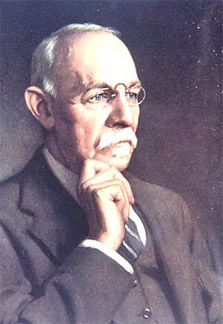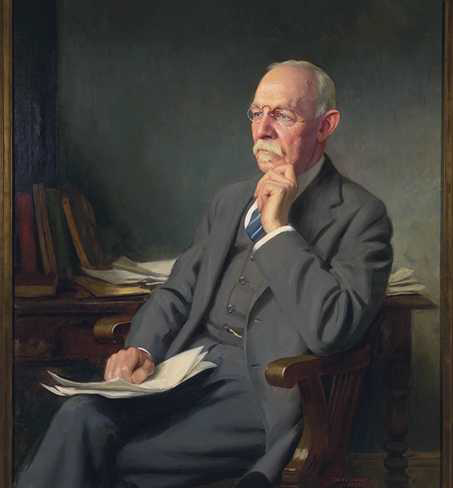<Back to Index>
- Surgeon William Stewart Halsted, 1852
- Playwright Euripides, 480 B.C.
- Prime Minister of Italy Aldo Moro, 1916


William Stewart Halsted, M.D. (September 23, 1852 – September 7, 1922) was an American surgeon.
William S. Halsted was born on September 23, 1852 in New York City. His
mother was Mary Louisa Haines and his father William Mills Halsted, Jr.
His father was a businessman with Halsted, Haines and Company. Halsted
was educated at home by tutors until the age of ten, when he was sent
to boarding school in Monson, Massachusetts. He didn't like his new school and even ran away at one point. He was then sent to Phillips Academy in Andover, Massachusetts, where he graduated in 1869. He entered Yale College in 1870. At Yale, Halsted was captain of the football team, played baseball and rowed crew. Halsted entered Columbia University College of Physicians and Surgeons in New York in 1874. After three years, in 1877, he graduated with an M.D.. After graduation, Halsted joined the New York Hospital as
house physician, where he introduced the hospital chart which tracks
the patient's temperature, pulse and respiration. It was at New York
Hospital that Halsted met his closest friend, the pathologist William H. Welch. Halsted
then went to Europe to observe the great European surgeons and
scientists, including Chiari, Zuckerkandl, Schneck, Billroth, Braun, Wölfler,
Mikulicz, Kölliker, Stoehr, von Bergmann, Volkmann, Schede,
Esmarch, and Bassini. He returned to New York in 1880 and for the next
six years led an extraordinarily vigorous and energetic life. He
operated at multiple hospitals, including Roosevelt Hospital, the College of Physicians and Surgeons, Charity Hospital, Emigrant Hospital, Bellevue Hospital and
Chambers Street Hospital. He was an extremely popular, inspiring and
charismatic teacher. In 1882 he performed one of the first gallbladder surgeries
in the United States (a cholecystotomy performed on his mother on the
kitchen table at 2 A.M.). He also performed one of the first blood
transfusions in the United States. He had been called to see his sister
after she had given birth. He found her moribund from blood loss, and
in a bold move withdrew his own blood, transfused his blood into his
sister, and then operated on her to save her life. On October 11, 1884 Halsted read a report, from Dr. Carl Koller, describing the anesthetic power of cocaine when
it is instilled into the eye. Halsted realized that cocaine may be a
great local anesthetic. Having learned the scientific method when he
was in Europe, Halsted, together with his students and fellow
physicians, began to experiment with cocaine. They injected each
other's nerves and showed that cocaine when injected into a nerve can
produce safe and effective local anesthesia. Halsted became addicted,
and was eventually sent to Butler Sanatorium in Providence, Rhode Island. There they attempted to cure him by converting his addiction from cocaine to morphine.
After being discharged from Butler in 1886, Halsted moved to Baltimore,
Maryland, to join his friend William Welch at the soon-to-be-opened Johns Hopkins Hospital. Halsted
was named the first chief of the Department of Surgery at Johns Hopkins
Hospital when it opened in May 1889. He was named surgeon-in-chief in
1890 and promoted to professor of surgery in 1892. At Johns Hopkins,
Halsted was credited with starting the first formal surgical residency
training program in the United States. Halsted’s
surgical residency program consisted of an internship (the length was
left undefined and individuals advanced once Halsted believed they were
ready for the next level of training). Internship was followed by six
years as an assistant resident and then two years as house surgeon.
Halsted’s first resident was Frederick J. Brockway, who started in May
1889 but dropped out of the program in October 1890 to teach anatomy.
Halsted went on to train many of the academic surgeons of the time
including Harvey Cushing and Walter Dandy. He is also known for many other medical and surgical achievements. As one of the first proponents of hemostasis and investigators of wound healing,
Halsted pioneered modern surgical principles of control of bleeding,
accurate anatomical dissection, complete sterility, exact approximation
of tissue in wound closures without excessive tightness, and gentle
handling of tissues. The first radical mastectomy for breast cancer was
performed by Halsted (before this time, such a diagnosis was a virtual
death sentence). Other achievements included the introduction of the
surgical glove and advances in thyroid, biliary tree, hernia, intestinal and arterial aneurysm surgeries. Though raised a Presbyterian, Halsted was an agnostic by adulthood. In 1890, Halsted married Caroline Hampton, the niece of Confederate general Wade Hampton III. They purchased the High Hampton mountain retreat in North Carolina from Caroline's three aunts. There, Halsted raised dahlias and pursued his hobby of astronomy. He died on September 7, 1922.